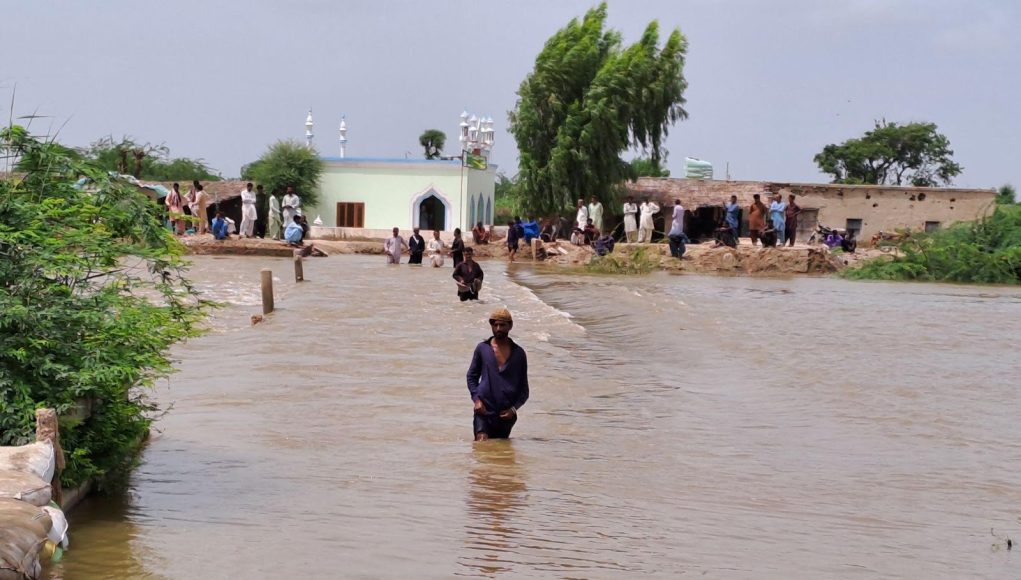A man was walking down a submerged bridge outside Karachi, Pakistan this past July with water up to his waist. Journalist Lubna Jerar and her colleagues were sitting nearby as he approached, taking in the man and the waves surrounding him in a place that not long had been bone dry. They had heard that volunteers planned to drain the water and understood how big of a job it would be.
“It was like a Moses moment for myself and my colleagues,” Jerar says, “We were like, ‘What’s going on?’”
Pakistan has recently suffered once-in-a-generation flooding. One-third of the country is underwater. Thousands have had to leave their homes. Even the tragedy in Cape Coral, Florida, was not as immense – at least geographically – as the catastrophe that occurred in the nation next door to India. The Pakistani floods have resulted in 308 fatalities, which is 207 more deaths than the Cape Coral tragedy.
As multiple articles about the floods spread around, the first person to report its devastation was Jerar, a 51-year-old journalist based in Lahore. She wrote about coping with the issues emerging from the crisis and tried to make the public and authorities understand its magnitude.
“Act now, or Pakistan could be looking at an enraged starving mob of millions, an extremely dangerous situation,” she wrote in Daily Times this August, urging politicians to speak out about the floods.
Born to a family of writers, poets and journalists, Jerar’s interest in writing was practically innate. She started as early as six years old, writing a school play in which she played a part. Then at 10 years old, she had her first short story published in “The Mirror of the Month,” a popular social magazine in the ’50s through the ’70s.
After completing her bachelor’s degree at St. Joseph Women’s College in Karachi, her older cousin introduced her to You magazine, where she worked as a sub-editor while studying law in Karachi.
During this time, she also worked at Us Magazine For the Youth. There she covered stories of the youth in Pakistan. One of her most memorable moments there came when she and a colleague received a report from someone who said they had suffered molestation. They responded by telling them to take action against it.
“We got really angry, me and my colleague. We wrote saying that you should take action against them,” Jerar says.
Eventually, an organization that dealt with issues such as sexual abuse commended the magazine for reporting the story.
This particular instance incentivized Jerar to keep writing about women’s issues, which is why she writes about how women are affected by the environmental crisis today.
Before the crisis, for most of Jerar’s career, she freelanced for news sites such as Geo and The News, writing predominantly on topics such as gender, human rights, civics, social issues and climate.
She was best known as a gender coordinator at the International Federation of Journalists in Pakistan who advocated for women’s rights since the start of her career. She became an even more passionate advocate due to living in Pakistan, a primarily Muslim nation where patriarchy is prominent. In 2017, Jerar received a South Asian Laadi Media Award – an important regional prize – for promoting gender sensitivity in the media.
Now, she hopes to use traditional and social media platforms to educate the public on the crisis, and earlier this year, she became one of the few reporters, and the only woman, covering the floods. Female reporters in other other areas ravaged by the floods, such as Balochistan, west of Karachi, were forbidden to leave their homes due to the destruction and the danger it posed, as threats of rape and misconduct were prevalent.
As the monsoon season began pouring down in mid-June, Naqvi says there was limited domestic coverage of the flooding due to politics taking over the media. Instead, reporters from outside the country were the ones that sparked action.
“A lot of the time, the reporting [on the flood] was done for foreign media from Pakistan,” she said. “For the local media, fewer people were working on it, and it was usually about the weather.”
However, reporting on the crisis is increasing just slightly as the intensity of the floods heightens, affecting both poor and well-off citizens.
One issue arising from these floods is the looming food crisis as the floods destroy the country’s crops, such as wheat and livestock. This has placed the entire economy of Pakistan in penury due to the country’s dependence on its agricultural sector, which contributes 18.9 percent to the GDP and absorbs 42.3 percent of the labor force.
“This was supposed to be the season when the crops were harvested and now we have lost food and potential crops for other seasons,” says Jerar.
Moreover, as problems continue to rise, there is also a substantial lack of reporting on these issues surfacing due to the floods.
Because of this, environmental journalists like Jerar are resorting to social media such as TikTok, WhatsApp and Facebook to reach a broader audience so they can encourage others to speak up about these issues and influence policymakers to make better decisions.
“Digital and social media have helped [people] to understand that this is very serious,” Jerar explains.
Jerar stresses that informing the people living in the cities through social media is extremely important as they are more well-educated and can vocalize their concerns about the economy and the problems people in rural areas face. Thus, Jerar herself has turned to YouTube and articles to document the flood’s destruction.
In recent years, Jerar explains, Pakistanis have educated themselves on environmental issues such as climate and water.
“People are becoming more literate about climate and not wasting water,” she says. “They are being conscious of these things and slowly speaking up now.”
Along with social media, the United Nations has helped spread awareness about the floods and added pressure on the Pakistani government, which has resulted in more public discussion about the crisis.
“It’s a start,” Jerar comments about the U.N.’s help. “Unfortunately, 33 million people have already been affected [by the floods]. We don’t even know the extent of the destruction yet.”
Currently, civilian volunteers and government aids are working on the front lines of the crisis to conduct rescue operations and provide relief such as shelter and food. Unfortunately, these relief programs exacerbate the probability of a food crisis.
“We’ll have to import [food],” Jerar explains. “It will put a lot of pressure on our economy. So we need to think ahead and the media needs to speak up about that right now.”
Afia Aslam, another female journalist in Pakistan who has interacted with Jerar through media-related forums, describes her as courageous, forthright and articulate.
“She is determined to be the voice for the voiceless and is a source of inspiration and strength for other journalists, especially female journalists,” stated Aslam.
In the future, Jerar wants to keep focusing on beats such as environment and gender to give those stories a bigger platform. If the Pakistani media keeps neglecting them, Jerar hopes to launch her own social media platform that curates stories about those forgotten beats.
“The most important beats like gender and environment are ignored and underrepresented,” she says. “We need to work in these fields. It has a lot of scope for a journalist to work in.”

































